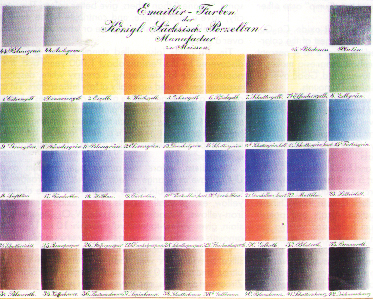
Overglaze palette, Meissen, Germany
ART 198 - HISTORY OF WORLD CERAMICS
| Under the direction of Johann Höroldt, Meissen greatly expanded the color palette available for decoration, and this image is a reproduction of the color table that was developed by Höroldt for overglaze decorators to use as a reference. Overglaze colors are simply very low temperature glazes, usually lead based. After a piece of porcelain had been fired to high temperature, then on top of this hard, fired surface, overglazes could be applied. Overglazes are mixtures of glass, lead, binder, and pigment. The lead acts as a flux, melting the glass at a very low temperature (around 1300° F). The binder used was often an thick oil, which would allow the overglaze to 'stick' to the glazed surface. During the firing the oil would burn away, leaving the melted glaze sitting on top of the previously fired high temperature glaze. Pigments used were the usual oxides of iron, cobalt, copper, manganese, antimony, and chrome. By blending and mixing these colors, Höroldt was able to create a rich and nuanced palette of colors with which to work. The main advantage of overglazing is that colors that cannot be achieved at porcelain temperatures can be attained at this lower temperature. The main disadvantage is their relative impermanence. Abrasion will cause the color to wear away. Many of these colors can be seen on the last image of Punchinello, by Kändler. | Overglaze palette, Meissen, Germany |
|
|